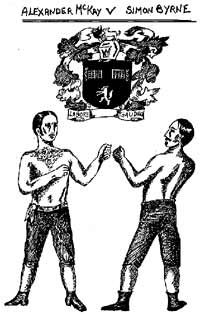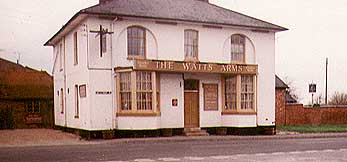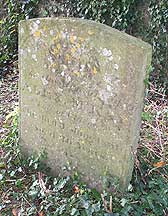
Alexander McKay, champion of Scotland, fought Simon Byrne, an Irishman, at Salcey Green on the 2nd June 1830.
The match had been made at a sporting dinner at the Castle Tavern, Holborn, for £100 a side.
The patrons were Gentleman Jackson, Tom Cribb and Tom Spring, landlord of the Castle Tavern.
It is difficult for us today even to imagine the horror of these prizefights. The boxers fought bare-fisted. A round was not a fixed time but a fresh set-to after a fall. A man was given half a minute to lie after a fall, and if his seconds did not bring him to the ‘scratch’ – ie the middle of the ring – by the end of that time, he was deemed to have been defeated.
Our fight went to 47 rounds but contests of 80 or 90 rounds were not uncommon. Needless to say, huge sums of money were at stake – not of course for the poor fighters. Bouts like McKay v Byrne would attract large bets from London society and local gentry as well as from the country folk.
The fight itself was to have taken place in Hanslope, probably by the Watts Arms. However, Thomas Evans, the Parish Constable, was called by the grand-sounding ‘High Constable of Stony Stratford and Newport Pagnell’ to prevent the match. In his evidence at Byrne’s trial Evans said ‘I attended at the Watts Arms for some time – there were a great many persons there; I did not see the prisoner there – I went from thence to Hartwell in Northamptonshire; saw a great number of persons assembled, and saw two men fighting…’ There is some dispute about whether the fight was in Hanslope parish or across the border in Hartwell. Most recent historians agree that the location was at Salcey Green, a few hundred yards inside Northants.

Constable Evans’ failure to stop the prizefight is explained away by a local story worthy of a romantic historical novel. McKay, the champion of Scotland, is said to have been smuggled out of the Watts Arms through the bar window facing Long Street. In the meantime, the constable’s attention was colourfully diverted: Rosamund Dee, ‘the landlord’s niece’, came downstairs and out of the front door of the inn wearing a kilt! This obviously proved too much of a distraction for the officer of the law. We can only guess at how Rosamund acquired the kilt; perhaps it was McKay’s.

The efforts of the ‘Sweeney’ of the day – the Bow Street Runners – were no more successful. But George Ledbetter, an officer of Bow Street, did manage to stop the fight being held either on Crown land or on the Duke of Grafton’s estates. Ledbetter was sent by the Duke’s son, the Earl of Euston, who did not want the forest damaged and his profits from timber sales reduced. Needless to say both Runner Ledbetter and Constable Evans stayed to watch the fight. After 47 rounds of bare-knuckle fighting, McKay was unconscious. Evans described the end: ‘…in the last three or four rounds the man called McKay appeared very much beat; in the last round McKay was knocked down, or fell down; did not exactly notice what occasioned the fall; he appeared quite helpless; and could not stand’.
The defeated champion was attended by Mr James Heygate, a surgeon living at Hanslope. He bled McKay upon the field, had him taken to a carriage and then back to the Watts Arms. The boxer died there the next day at 9 o’clock in the evening. He was 26 years old. He died of brain damage which was not helped by the very rough road from the ring to Hanslope and by being carried up the inn’s narrow staircase feet first. We can only hope that Dr. Heygate took more care of his other patients.

McKay was buried in Hanslope churchyard under a tombstone bearing a rhyming epitaph:
Strong and athletic was my frame
Far from my native home I came
And bravely fought with Simon Byrne
Alas, but never to return.
Stranger take warning from my fate
Lest you should rue your case too late
If you have ever fought before
Determine now to fight no more.
A few days later Simon Byrne was arrested for McKay’s murder. According to the Northampton Mercury of 12th June 1830 he was taken ‘on board the Dublin packet, on Saturday evening without a warrant. He arrived at the White Lion, Liverpool, on Saturday afternoon, by the coach, whither he was pursued by some officers who had heard of the fatal result of the fight, took upon themselves to take him into custody, and he now remains in the gaol of that town till further instructions shall be received.’
The kind of backing that prizefighters enjoyed was shown at Byrne’s trial. He was represented by three learned counsel and five solicitors. In addition, twelve witnesses came from London and were put up at the White Hart and other Buckingham inns at considerable expense. The trial was held at the Buckingham Assizes. Byrne, described by the Bow Street Runners as a ‘very human kind man’ did not testify. But witnesses made it clear that McKay ‘a very large muscular man – a magnificent man’ was taller and bigger than the prisoner. There was also interesting evidence from George Pacey of Castlethorpe who saw McKay ‘before the fight took place go from a close near the Watts’ Arms; he got over a gate in going from the close, and fell on the ground on some rough stones; the gate flew open as he was putting his hand on it to get over; he fell with his head on the stones; he got up however, and then went on to the fight.’ The Glasgow Free Press started a rumour that McKay was drugged by a sleeping draught slipped into his water bottle. Whatever the true facts, the jury took only ten minutes to return a verdict of not guilty which was received with ‘the loudest and most boisterous acclamation, which it required some exertions on the part of the officers in Court to suppress’. For the rest of the day the town was apparently in ‘ecstasies’ and the ‘feeling of triumph universal’. A plaque in the Watts Arms commemorated the fight and the careers of both men.
Byrne’s triumph was short-lived. Three years later he fought James ‘Deaf” Burke for the championship. This fight was held at St Albans, went 99 rounds and lasted three hours and sixteen minutes. Burke, who according to newspaper reports had been sustained by brandy when on the point of collapse, smashed his man to the ground in a final terrible rally. Simon Byrne died three days later after the longest recorded prizefight. The Fancy, the patrons of prize fighting, sank into deep disgrace and general infamy.
Perhaps the last word should be left to The Times which in the same year condemned the ‘barbarous, filthy and swindling exhibitions called prize fights’:
‘As to the other miscreant who worked for hire and has therefore accidentally come under the denomination of assassin we say nothing, but we do hope … that an example will be made of the more wealthy monsters in this affair of blood – the sanguinary cowards who stood by and saw a fellow creature beaten to death for their sport and gain.’